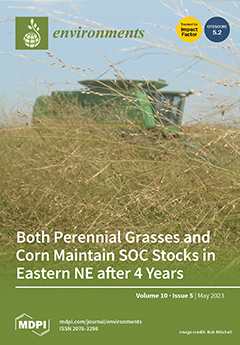The present research provides data on the density (
ρ), viscosity (
η) and ability to absorb carbon dioxide of systems containing amine, molecular solvent (MS) and choline chloride (ChCl), with the investigation of the physical properties of both neat amine/MS/ChCl
[...] Read more.
The present research provides data on the density (
ρ), viscosity (
η) and ability to absorb carbon dioxide of systems containing amine, molecular solvent (MS) and choline chloride (ChCl), with the investigation of the physical properties of both neat amine/MS/ChCl mixtures and their samples after complete CO
2 saturation. The effect of the mixture composition was studied by varying amine from primary (monoethanolamine, MEA) to secondary (diethanolamine, DEA) and tertiary (triethanolamine, TEA) amine, and the degree of its substitution from a mono- (MEA, DEA and TEA) to a doubly-substituted (ethylenediamine, EDA) compound. The role of an MS was investigated via the exchange of ethylene glycol (EG) with water and dimethylsulfoxide (DMSO). In addition, the influence of the CO
2 absorption promoters present in the ternary MEA/EG/ChCl mixture at an amount of 5 wt. % was also investigated. We show that an increase in
ρ and
η in the amine/EG/ChCl mixture affects the properties of neat amines. This suggests that in the studied ternary mixtures, the nature of the interspecies interactions is very similar to those in the previously studied MEA/EG/ChCl system. When EG was exchanged for H
2O or DMSO, a decrease in
ρ and an increase in
η were observed. A comparison of the data with the corresponding properties of the systems composed of each pair of the mixture components indicates that the intensity and/or number of interspecies interactions in the present ternary mixtures were stronger than those in pure H
2O, DMSO and MEA. While in the presence of promoters no significant changes in the studied properties were found, for the corresponding CO
2-saturated samples, the
ρ and
η increased proportionally to the amount of absorbed gas. This was also the case for all the systems studied in the present research. The overall CO
2 absorption of the EG-based mixtures decreased when going from primary to secondary and tertiary amines; it was 21% higher for the MEA/H
2O/ChCl system compared to the mixtures containing EG and DMSO, which, in turn, showed similar absorption capacities. When the promoters were added to the MEA/EG/ChCl mixture, the highest capacity was found for the piperazine-containing system.
Full article





